In this piece, Helen Breewood introduces the environmental impact nuances behind trending vegan and flexitarian consumption patterns. Helen wrote this post in her personal capacity. Note that the FCRN has no financial affiliation with any of the brands mentioned in this blog.
Helen Breewood is a research assistant at the FCRN. She is also a freelance writer and blogs about solving global sustainability issues at The Progress Motive. You can find her on Twitter.
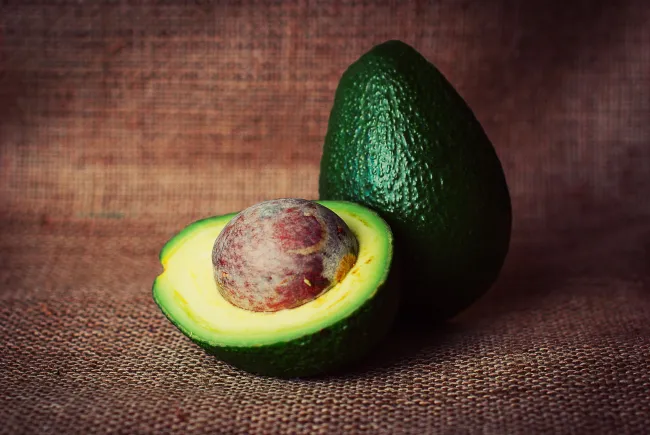
 Cover image: tookapic, Avocado vegetable cut, Pixabay, Pixabay Licence
Cover image: tookapic, Avocado vegetable cut, Pixabay, Pixabay Licence
Vegan food is in fashion, and not just among the increasing numbers of vegans - many Brits are cutting down their meat intake, in a trend known as flexitarianism. As a vegan living in the UK, I’m noticing a lot of changes: supermarkets and restaurants are cashing in by offering new vegan options, Instagram is bursting at the seams with avocados and colourful Buddha bowls, and bloggers such as Deliciously Ella are making plant-based foods mainstream. This new-found popularity of vegan foods has been hailed as great news for the planet - but might these changes have unintended consequences? How much do we really know about the environmental and social sustainability of modern plant-based eating?
Total diet impacts
Modern supermarkets offer fresh produce all year round and have an increasing variety of vegan ranges. A few decades ago, vegans might have had more limited options: seasonal vegetables, grains, lentils, tofu. Do studies looking at the environmental impacts of various dietary patterns account for the far wider range of vegan choices that are available nowadays?
One study (Scarborough et al., 2014) calculated the greenhouse gas emissions caused by the self-reported diets of meat-eaters, fish-eaters, vegetarians and vegans in the UK, and concluded that vegan diets have around half the emissions of omnivorous diets. However, while the database of food emissions that the study used does include vegan protein sources such as soybeans and other pulses, it doesn’t appear to include several alternatives such as some nuts and seeds, tempeh, tofu, mycoprotein (used to make Quorn) and processed meat replacements. Perhaps more importantly, the dietary data was collected in the 1990s and may not reflect the composition of current diets, vegan and otherwise. Many products available now simply weren’t around then, such as Quorn’s vegan range (regular Quorn contains egg white).
Another study using more recent consumption data from Italy (Rosi et al., 2017) found that, on average, vegan diets in the study sample had lower carbon, water and ecological footprints than omnivorous diets. However, there was a lot of variability between individuals. Some vegans had higher dietary impacts than some omnivores. Two vegan participants had extremely high dietary impacts, on par with the highest impact omnivorous diets - it turned out that they ate only fruit!
Veganism is clearly not an inherent guarantee of eco-friendliness. Personally, since environmental concerns were the main reason I switched to a vegetarian diet 11 years ago and to a largely vegan diet a couple of years ago, it’s worrying to think that I could inadvertently be choosing high-impact foods. Here are a few issues that I would love to see more information on.
Palm oil
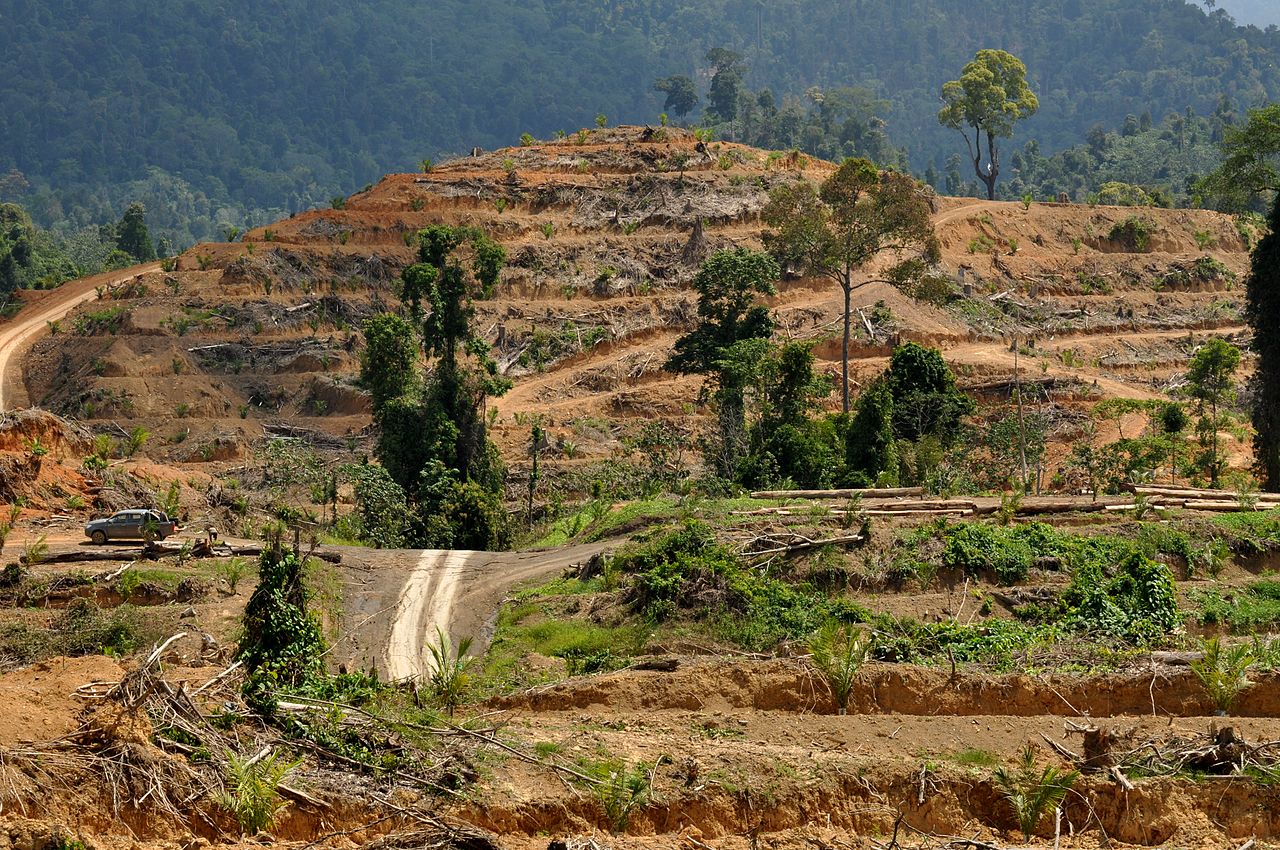
Image: T. R. Shankar Raman, Land cleared for oil palm plantation in Sabah, Borneo, Wikimedia Commons, CC BY-SA 4.0
Nowadays, there are many plant-based replacements for dairy products such as butter, ice cream and cheese - Tesco and Sainsbury’s have even developed their own vegan cheeses. But I’ve often spent a long time puzzling over which brand to buy, if any. Besides having questionable nutritional value - many dairy alternative brands are high in fat with little protein - it’s very difficult to avoid palm oil.
Palm oil plantations cause deforestation and push species such as the orangutan further towards extinction. So which causes more animal suffering and biodiversity loss - dairy farming or palm oil induced deforestation?
Some brands do contain a “sustainable” certified version of palm oil. For example, Unilever, who make the vegan ice cream Swedish Glace, claims to be taking steps towards responsible palm oil sourcing, as does dairy-free spread manufacturer Pure Free From.
But does certification actually reduce overall rates of deforestation, or does it just shift the blame to other, uncertified, producers? Might the availability of “sustainable” palm oil actually increase overall market demand for palm oil, or encourage different crops to be grown on deforested land? Greenpeace claims that the Roundtable on Sustainable Palm Oil’s standards still permit deforestation and peatland destruction. Further complicating the issue, replacing palm oil with other fats such as olive or sunflower oil wouldn’t necessarily be a sustainable solution, since these crops use 5 to 8 times as much land as palm oil to produce a given quantity of oil or fat.
Coconut oil
Coconut oil is another ingredient found in many dairy replacements. It’s also popular with the paleo and clean eating movements (although it may now be losing ground to butter and ghee).
Could coconut oil cause deforestation in the same way as palm oil? Ethical Consumer says that deforestation isn’t a serious issue with coconut farming, but that producers are often in extreme poverty. While Fairtrade coconut products are available, a 2014 study by SOAS and the LSE concluded that the benefits of Fairtrade are debatable, particularly for the poorest workers - although the Fairtrade Foundation itself has contested the study’s findings.
Soy
Tofu has been around for a long time – possibly thousands of years – and now soy beans appear in all sorts of products. However, soy production increased ten-fold between 1961 and 2009. Nowadays, soy plantations wreak havoc upon the environment, causing deforestation and soil erosion. In Argentina, the appearance of a new river has been blamed on soybean plantations.
75% of soy is actually used to feed animals. Since feeding an animal with soy gives you less food value measured in calories or protein than eating the soy directly, is it reasonable to assume that demand for soy would actually drop as the popularity of soy-based foodstuffs rises, because of reduced demand for meat?
The FCRN-WWF report* How Low Can We Go? makes a rough estimate that, in the UK, replacing UK-produced beef and sheep meat with tofu, Quorn and pulses (in proportions of 20%, 20% and 60%, respectively) would require more overseas land while reducing arable land use in the UK (see Table 39 of the report). This is partly because substitutes such as soy, chickpeas and lentils are generally not grown in the UK and partly because some of the chosen pulses (lentils and chickpeas) have low yields per hectare. As the report notes, choosing higher-yield pulses could reduce the overseas land required. While using more land overseas, the substitution of ruminant meat with alternatives could free up some arable land in the UK previously used to grow feed crops. Perhaps the answer is to grow more pulses in the UK, such as broad beans, dried peas or haricot beans. For more on this option, see the blog post that Tom Kuehnel of The Vegan Society wrote for the FCRN.
The FCRN-WWF report also estimates the land required for pig and poultry meat and their substitutes. Table 29 shows that the arable land needed to produce feed crops for UK-raised pig and poultry meat is 1,109 kha in the UK and 968 kha elsewhere (note that the model used for land use calculations does not attribute any grassland to the production of pig or poultry meat in the UK – see Table 28). Table 38 shows that substitutes (soy, other pulses and sugar to cultivate Quorn) for UK-raised pig and poultry meat would use 659 kha of land in the UK and 2,946 kha of land elsewhere. This suggests that replacing UK-produced pig and poultry meat with substitutes would reduce UK land use and increase overseas land use.
Taking a global perspective might give a different answer, as other countries might rely on different mixes of grass-fed, grain-fed or soy-fed livestock. There might also be differences in the growing conditions of soy for animal feed and human food. For example, food-grade soybeans are higher in protein than feed-grade and require more careful processing to ensure that weeds don’t contaminate the harvest - does this change their environmental impact?
These are important questions. Are they adequately addressed by brands that use soy beans?
Alpro say they use soy beans that are certified by the ProTerra standard, which requires non-GMO beans, good labour practices, protection of community rights and specific agricultural practices related to soil fertility, water management and reduced inputs of fertilisers and pesticides. Alpro also source some of their soy beans from European countries and are developing varieties suited to the climates of France and Belgium.
Other brands, however, are less specific. Tofoo, for example, say they use organic beans and draw attention to their “all-natural” ingredients, but haven’t replied to an email requesting their sustainability policy at the time of writing this blog post. Meanwhile, Cauldron Foods say that their soy beans, grown in Canada, China and Europe, are sourced from “strict sustainable areas where the beans must be grown in ways that are organically, ecologically and ethically good”, but don’t explain exactly what this means. Clearspring don’t mention sourcing policies at all in their environmental standards.
Processed meat replacements

Image: Quorn, Lemon and Chilli Linguine with Quorn Meat Free Pieces, Quorn Media Centre
How sustainable are highly processed meat replacements?
Perhaps the best-documented brand is Quorn, which is based on mycoprotein. A simplified life cycle assessment report from 2010 (the author of that study currently works at Quorn, but it’s not clear whether this was an official Quorn publication) estimated that two vegetarian Quorn products (mince and pieces) have a slightly higher carbon footprint than poultry but considerably less than beef. Removing the egg in the formula (used to bind the ingredients) would halve Quorn’s emissions, but data showing the impacts of Quorn’s more recently produced egg-free vegan range are not available.
However, Quorn’s official 2017 Sustainability Report claims that Quorn mince has a carbon footprint 90% lower than beef, and that Quorn pieces have a carbon footprint 70% lower than chicken. Since the document cited for these figures is not publicly available, it’s not possible to check why they don’t tally with the earlier study. I emailed Quorn to see if they could provide the reference for these figures and an estimated carbon footprint for their vegan range. They said they would look into it but haven’t been in touch since then. [Edit, April 2020: Quorn have now published a Carbon Footprinting Emissions Report (PDF link) and a 2018 Quorn Footprint Comparison Report (PDF link), certified by the Carbon Trust. These show the following carbon footprints, measured from farm to factory gate: 1.2 kg CO2 eq./kg Quorn mince (which contains egg); 1.2 kg CO2 eq./kg Quorn pieces (which also contain egg); and 1.4 kg CO2 eq./kg Quorn vegan pieces. Quorn cites average farm-to-factory-gate carbon footprints of 27 CO2 eq./kg for UK beef and 5.9 CO2 eq./kg for UK chicken. That would mean that Quorn mince has a carbon footprint 95% lower than UK beef, and that Quorn vegan pieces have a carbon footprint 76% lower than UK chicken, when measured from farm to factory gate.]
Linda McCartney Foods and The Fry Family Food Co. who make meat replacements based on soy and wheat protein, both told me by email that they don’t have environmental impact data for their products.
Estimating the impacts of other meat replacements is not as simple as just adding together the impacts of the individual ingredients (often soya and wheat gluten), because of the importance of processing to the overall environmental impact of a given product. For example, culturing mycoprotein accounts for only 46% to 55% of emissions per tonne of Quorn, with the processing stages accounting for the rest. Are processing impacts similar for other meat replacements, and how do they compare to the impacts of processing meat?
The 2015 paper Meat alternatives: Life Cycle Assessment of most known meat substitutes finds that, in general, lab-grown meat and mycoprotein-based substitutes have higher environmental impacts than chicken, dairy and gluten-based substitutes, and that insect and soy-based substitutes have the lowest impacts of all. Clearly not all of these are vegan, including the mycoprotein option (assumed to contain egg). Variations between brands and future technological developments are likely to lead to variations in impacts.
Mushrooms
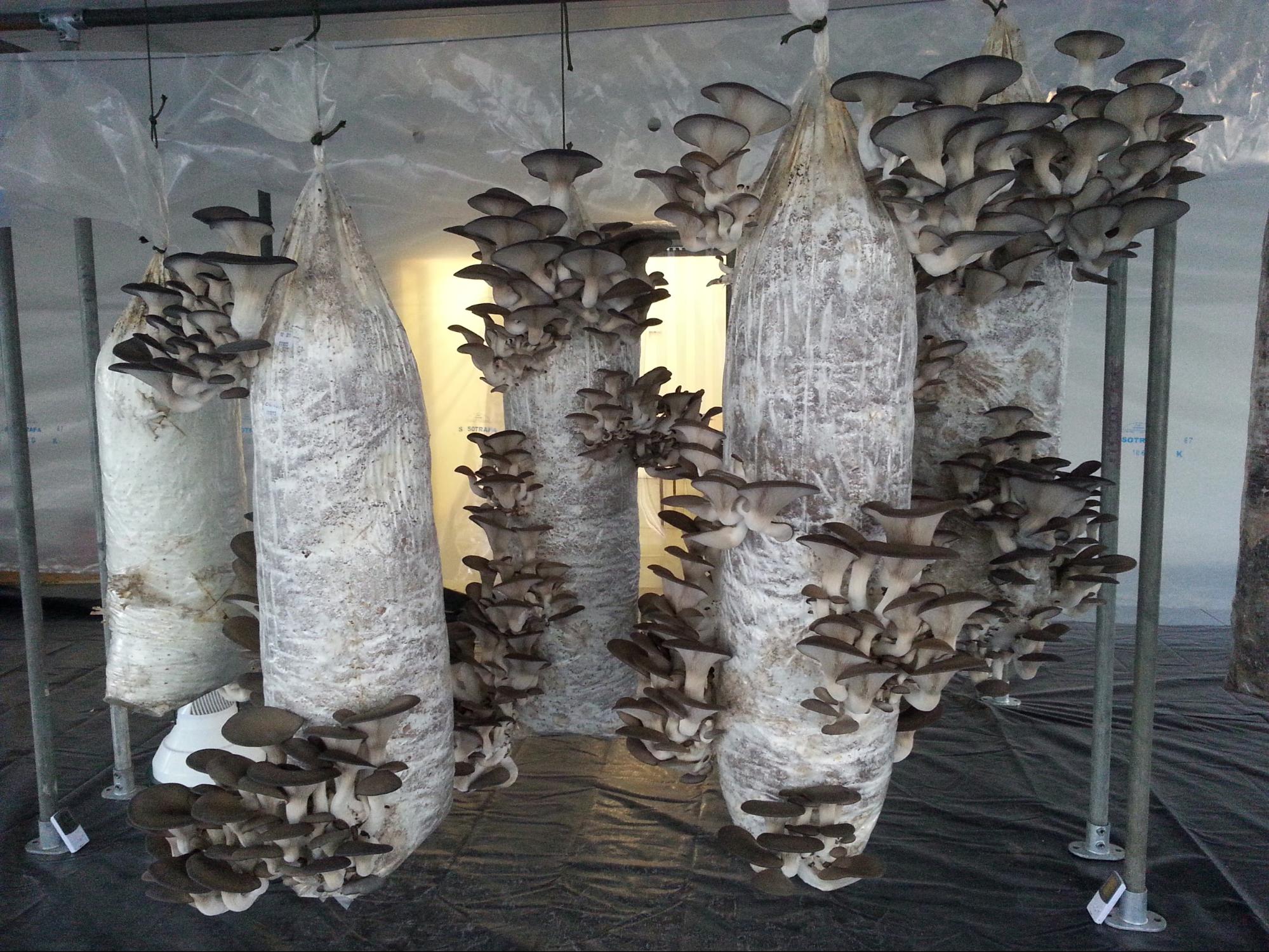
Image: GroCycle Urban Mushroom Farm, Grocycle press kit
Mushrooms have been in the news lately: the World Resources Institute, a US NGO, estimates that replacing 30% of the beef in beef burgers with mushrooms could reduce the water use, greenhouse gas emissions and land use of a burger by 29-30%. The advantage of these blended burgers is that they reduce impacts without requiring large lifestyle changes from consumers.
Mushrooms grow well on substrates that are byproducts of other processes, such as straw, sawdust, manure and even used coffee grounds. How many commercial mushroom farms actually use byproducts and how many use substrates produced specifically for mushroom growing? If demand for mushrooms were to rise, how would supplies of substrates need to change? And how, in turn, would that affect the environmental impacts of mushroom growing? I guess that many cafés still throw out their coffee grounds, perhaps providing an opportunity for more companies such as GroCycle’s Urban Mushroom Farm. However, there are logistical constraints: the coffee grounds need to be used very quickly, or else they go mouldy. Besides, would it be efficient, from the point of view of energy, to collect small amounts of coffee grounds from many cafés? GroCycle does collect coffee grounds by bicycle, but would this be true of other producers?
Another issue is that some mushroom farms use peat. As you may know if you are a gardener, peat extraction can damage peatlands, which are important wildlife habitats and stores of carbon.
Mushrooms don’t need light, so they can be grown in stacked layers without needing artificial lighting, but farmers do carefully control the air temperature and humidity to influence the size of the mushrooms. How much energy does this require?
Life Cycle Assessments are available for some commonly grown mushrooms, but do they cover all of the different types of mushrooms now on the market, and all different growing conditions and countries? For example, what about mushroom types that prefer to be grown on solid logs and take longer to mature and fruit than those grown on sawdust? What are the impacts compared to the foods that mushrooms might be replacing?
Imported fruit
Fruit isn’t just for vegans, but could a rise in veganism stimulate an increase the amount of fruit being consumed? What effects might that have?
Some fruits are now particularly popular with vegans and omnivores alike, or are finding new popularity through vegan recipes.
Take the iconically Instagrammed avocado. Avocados have been associated with illegal deforestation in Mexico, high water use in California and Mexico, questionable working conditions in many Latin American countries and trade controlled by drug cartels in Mexico.
What about fruits that are only recently becoming well-known in this country, such as the jackfruit - used to make mock “pulled pork”? A quick search for the environmental impacts of jackfruit doesn’t yield much useful information. Could it be that jackfruit doesn’t cause any problems? Or are the problems there, but hidden?
Bananas are practically a staple in supermarkets. They are also the basis of some delicious vegan recipes, such as this ice cream. While bananas are fairly low-carbon since they are grown in hot countries (and therefore don’t need to be grown in heated greenhouses) and are transported by container ship, there are serious questions over working conditions in the industry, as well as the vulnerability of banana plantation monocultures to disease.
With fresh produce, it could be helpful for shoppers to know which fruits have been air-freighted (very carbon intensive) or transported by container ship (relatively low carbon). Supermarket labels often give country of origin but rarely give the transport method. Since local food is not necessarily more sustainable, e.g. due to the energy used to heat greenhouses in the UK, transport information could be crucial when trying to choose the lowest carbon option. Tesco and Marks & Spencer did actually try this in the early 2000s, but found the labels had no effect on sales - but might similar schemes succeed now that consumers are more aware of climate change? Furthermore, what would the effects of such a scheme be on employment and economic development in low-income countries?
Water use
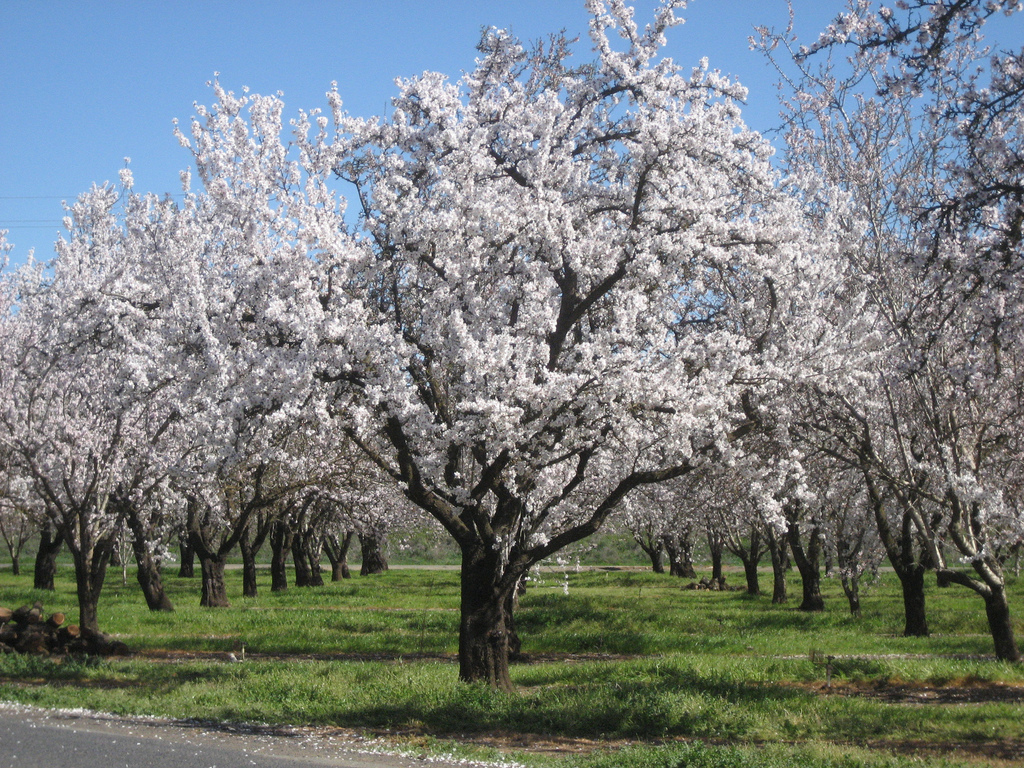
Image: Suzi Rosenberg, Almond orchard around February, Flickr, CC BY 2.0
Avocados aren’t the only product to use a lot of water. Almond milk, for example, may have a carbon footprint 10 times less than dairy milk, but it uses 17 times more water than dairy, according to one study. And as a recent study showed, almond milk is not nutritionally equivalent to dairy milk. With many almonds grown in California, which has only recently emerged from a drought, this could be a problem. One potential alternative is pea milk, claimed by its US makers Ripple to use much less water than almond milk. Ripple is not on sale in the UK, at the time of writing.
Dates are well suited to growing in dry regions, but in some areas there are politically charged issues of access to water.
What about other widely used vegan ingredients? The World Resources Institute’s interactive map of water stress shows that 50% of tree nuts, 38% of fruit and 32% of legumes are grown in areas of high or extremely high water stress. Of course, this doesn’t mean that vegan diets are necessarily to blame - these products are eaten by people following all sorts of diets, as well as sometimes being used as animal feed. Nevertheless, it will be important to watch the overall environmental effects of increases in the human consumption of these crops and corresponding declines in demand for animal products.
Economic effects
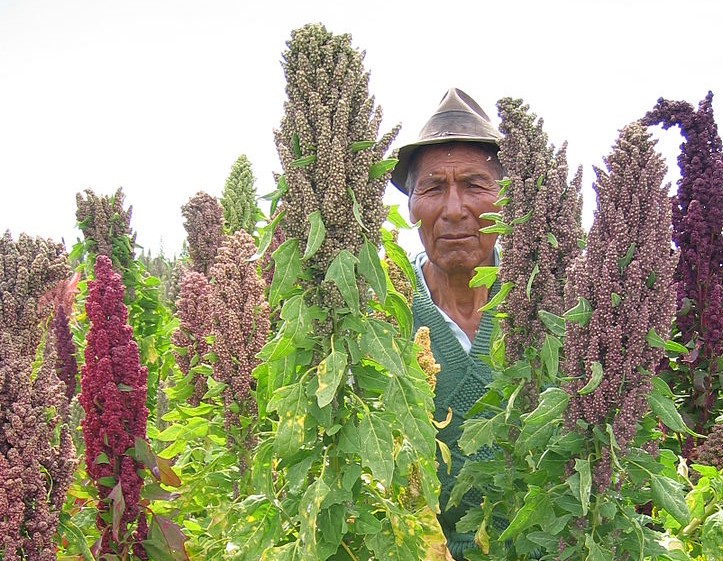
Image: Michael Hermann and Crops for the Future, Quinoa farmer in Cachilaya, Wikimedia Commons, Creative Commons Attribution-Share Alike 3.0 Unported
Demand for quinoa has driven up prices to the point where many poor Peruvians and Bolivians can't afford it, although it was a staple food for many. What are they eating instead, and is it more or less sustainable and healthy than quinoa? Do the economic benefits to the farmers outweigh the price swings? What other crops have risen in price due to popularity, and how are the economic effects changing global consumption patterns? How will changing markets drive investment and government policies?
Potentially lower-impact foods
While the foods I’ve listed above may raise a few alarm bells or at least question marks, it’s not all bad news. There are many trendy vegan foods that I think are likely to have low environmental impacts. Kale, for example, is popular on Instagram, but unlike the avocado it can be grown in the UK in winter. Aquafaba - the leftover liquid from a can of chickpeas - would normally go to waste, but has lately found popularity as an egg replacement for baking, mayonnaise and even chocolate mousse. One of my favourite recipes for cheesy pizza topping is based on potato, carrot, olive oil and nutritional yeast: it doesn’t use as much oil as many store-bought vegan cheeses and uses vegetables that are easy to grow in the UK. However, the environmental impacts of nutritional yeast are not clear. Producers Marigold Health Foods told me by email that the yeast is fed on beet molasses. Although they said that they expect that it has a low carbon footprint, they don’t have any evidence to prove it.
What do you think?
Personally, I am glad that vegan foods are becoming more popular, but there are many knowledge gaps. What do you think? Please do add your thoughts and feedback in the comments section below. What issues need to be explored most urgently for us to assess the impact of changing vegan diets and what needs to be done to address any downsides?
Would you like to write a blog post for the FCRN? We’re always happy to hear your ideas. Get in touch here.
*This article was edited on 29 June 2020 to cite specific tables from the FCRN-WWF report How Low Can We Go?, to make it clear that the estimate from Table 39 is for UK-produced ruminant meat only and to separately discuss the report's findings for pig and poultry substitutes.


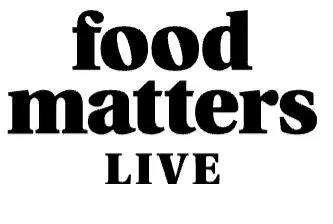




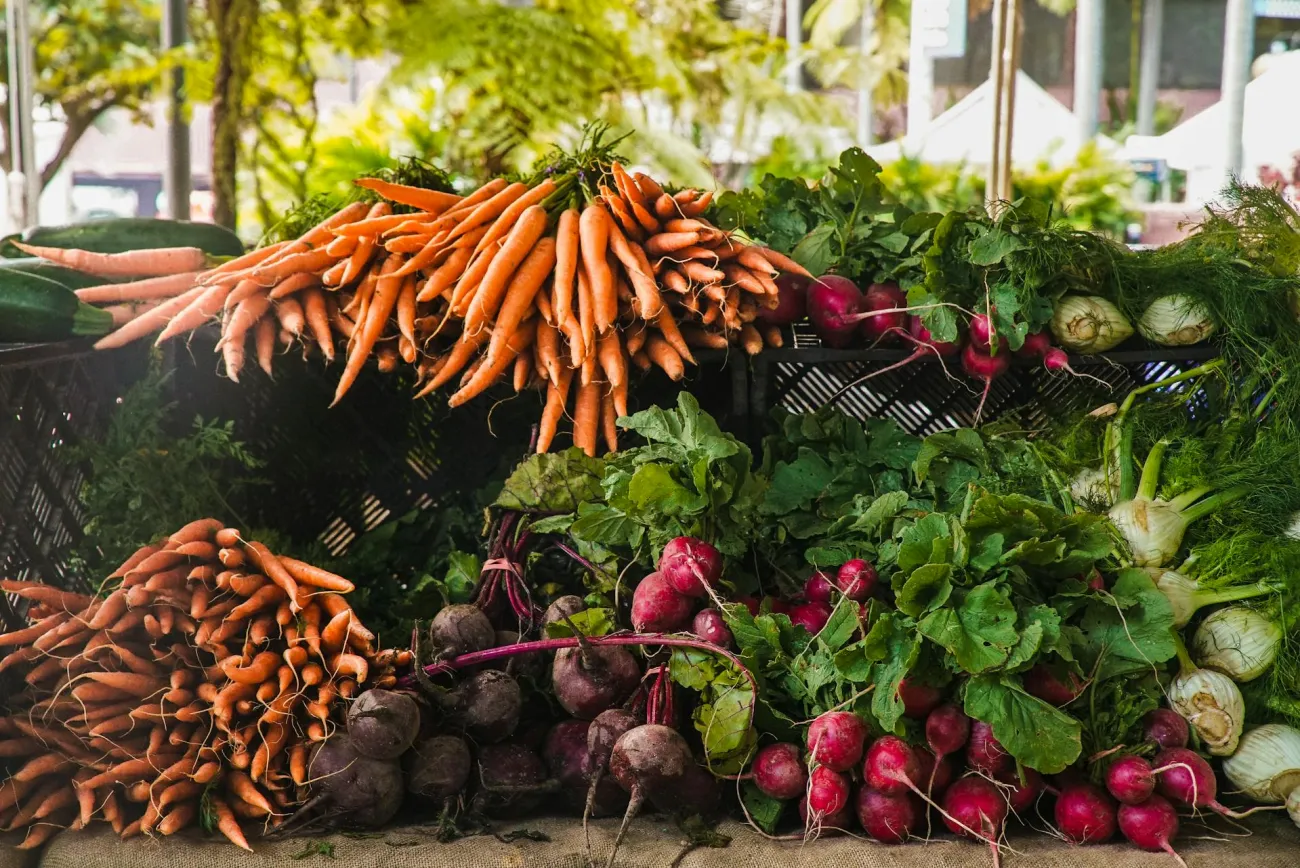
Comments (0)